LAB 6.1 Male reproductive system
Side view of reproductive system of the bull.
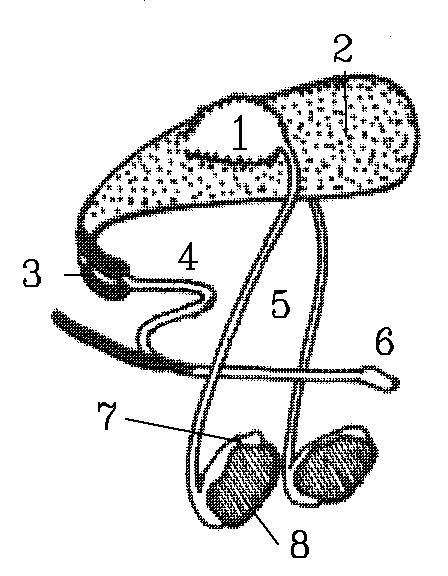
1. Seminal vesicle
2. Bladder
3. Cavernosus muscles
4. Sigmoid flexure
5. Vas deferens
6. Penis
7. Epididymis
PLAY VIDEO
The video shows the above diagram, followed by the reproductive systems
of the bull and boar.
The video also describes how the boar's bulbourethral glands are
related to 'boar taint' caused by androstenone.
Androstenone is a pheromone (a hormone transmitted from the boar to the
sow).
Males
- The paired testes of male farm mammals are located in a
muscular
bag called the scrotum where they can be maintained several
degrees
below body temperature for the efficient production of spermatozoa
or sperm.
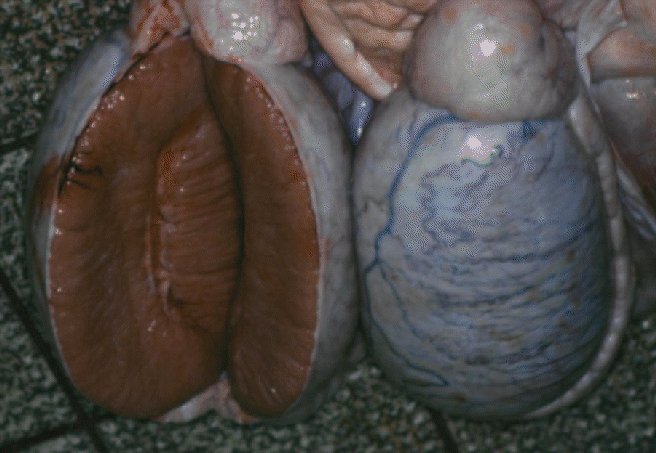 Here are two
boar testes, the one on
the left sliced open.
Here are two
boar testes, the one on
the left sliced open.
- Each testis can be raised by the cremaster externus
muscle.{Evidence
of cremaster muscles may appear in carcasses of sows and gilts and so
cannot
be used to identify male carcasses!}.
- The connective tissue round the testis is called the tunica
albugenia:
it is white with a good blood supply.
- Spermatozoa are produced in seminiferous tubules tightly
packed
into the oval shape of the testis.
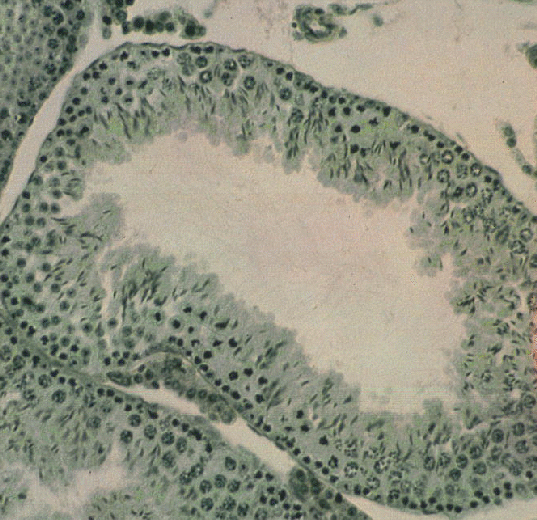 The
image
above shows one tubule under the microscope. The higher power image
below
shows part of the tubule (lumen downwards) with meiotic divisions
leading to the formation of spermatozoa, whose tails can be seen
faintly
at the bottom of the image.
The
image
above shows one tubule under the microscope. The higher power image
below
shows part of the tubule (lumen downwards) with meiotic divisions
leading to the formation of spermatozoa, whose tails can be seen
faintly
at the bottom of the image.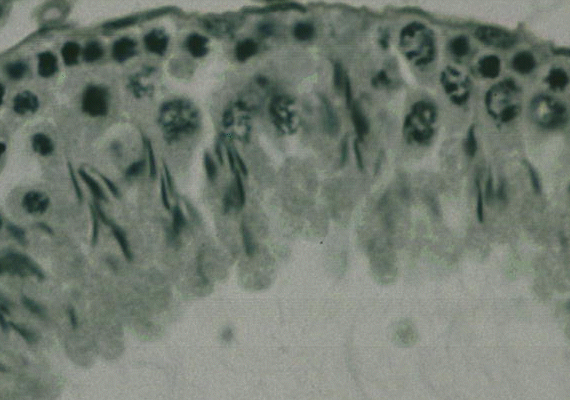
- The many seminiferous tubules in each testis open into a
labyrinth of tubes
called the rete testis. Immature spermatozoa from the rete
testis
pass in a number of efferent ducts to a further tubular system, the epididymis,
located on the surface of the testis,
as shown in the image below.
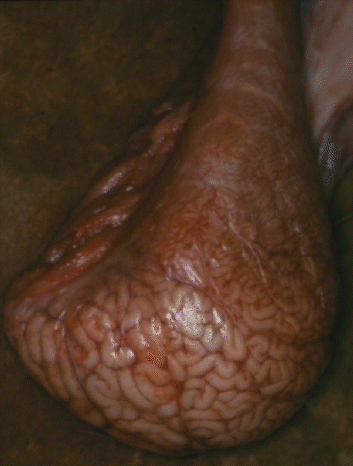
- Spermatozoa mature during storage in the epididymis and are
carried to
the urethra during mating by peristalsis of the vas deferens.
- The urethra is located ventrally in the penis.
- Seminal fluid to carry the spermatozoa is produced by the
paired seminal
vesicles, by the prostate gland, and by the paired bulbo-urethral
glands (= Cowper's glands). The glands are located along the
urethra,
near to the bladder. The image below shows the seminal vesicles
of a boar.
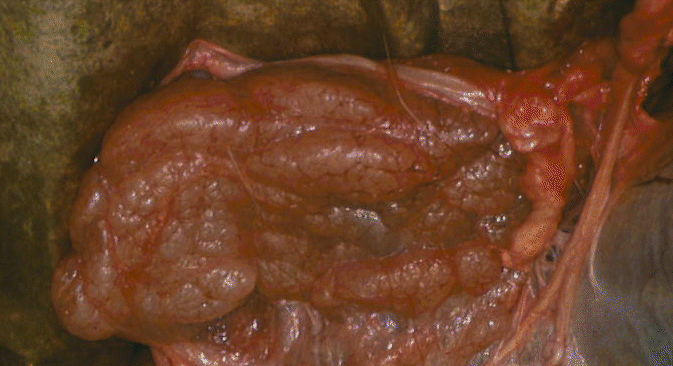
- The penis has a sigmoid flexure or S-shaped bend
along its
length. The sigmoid flexure is straightened out when the penis is
extended
for mating. This occurs when a pair of muscles, the ischio-cavernosus
muscles,
compress the veins which drain the blood from the penis. Arterial blood
pressure then expands the volume of vascular tissue in the penis.
- The ischio-cavernosus muscles are attached to the ischium
and the
trimmed stump of the muscle may be seen on dressed sides of beef as a pizzle
eye. The pizzle eye is poorly developed in steer carcasses and is
larger
and darker in bull carcasses.
- During the embryonic development of both mammals and birds, the
testes
are formed from tissue located near to the kidneys. In male mammals,
the
testes normally move to the scrotum outside the body cavity, and they
pass
through the body wall in the inguinal canal. The testes are
attached
to the inside of the scrotum by the gubernaculum which is
contractile
in fetal animals and is responsible for pulling the testis through the
inguinal canal.
- The layers of connective tissue that cover each testis are the
(1) tunica
vaginalis communis and (2) the inner layer formed by the tunica
vaginalis propria. Both layers are derived from modified layers of
peritoneum gathered by the testes during their migration. The inner
layer
supports the blood vessels and nerves to the testis.
- In cryptorchid pigs or ridgelings, movement of the testes
along
the inguinal canal is incomplete and they do not reach the scrotum.
This
abnormality causes infertility, but an older cryptorchid pig may still
develop boar taint like a normal boar. The cause of the
condition
is not fully known but the normal mechanism of testicular movement
appears
to involve the action of testosterone on the genito-femoral nerve which
then produces a peptide that activates the gubernaculum.
 Here are two
boar testes, the one on
the left sliced open.
Here are two
boar testes, the one on
the left sliced open.  The
image
above shows one tubule under the microscope. The higher power image
below
shows part of the tubule (lumen downwards) with meiotic divisions
leading to the formation of spermatozoa, whose tails can be seen
faintly
at the bottom of the image.
The
image
above shows one tubule under the microscope. The higher power image
below
shows part of the tubule (lumen downwards) with meiotic divisions
leading to the formation of spermatozoa, whose tails can be seen
faintly
at the bottom of the image.


